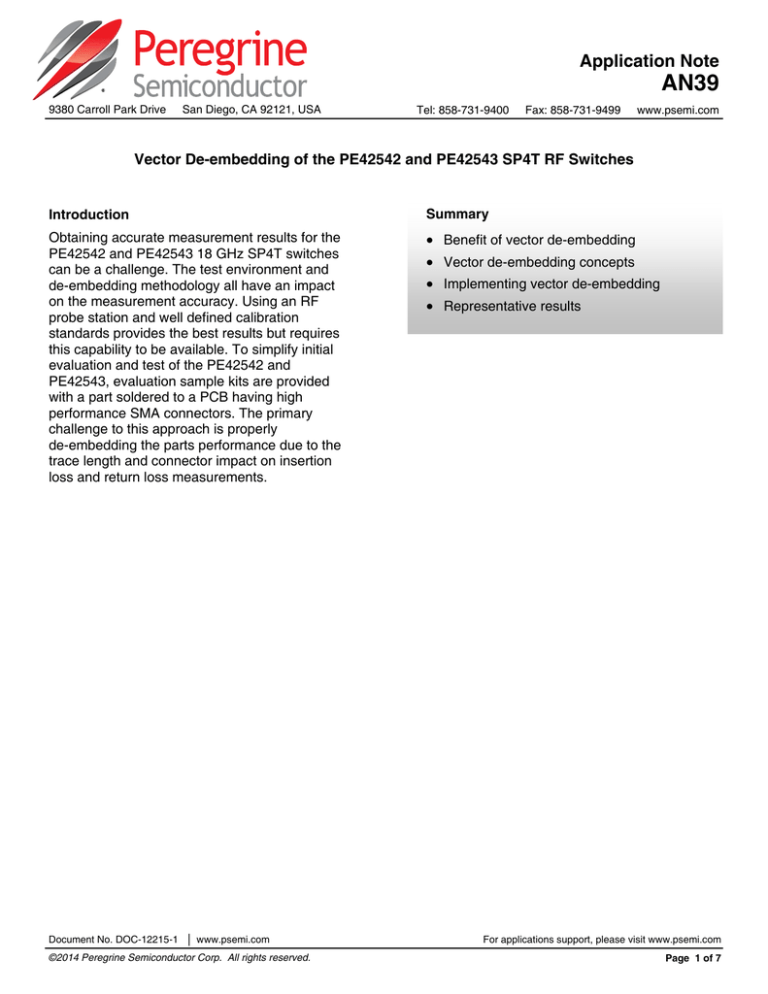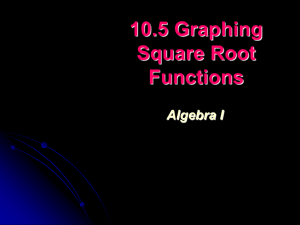
Application Note
AN39
9380 Carroll Park Drive
San Diego, CA 92121, USA
Tel: 858-731-9400
Fax: 858-731-9499
www.psemi.com
Vector De-embedding of the PE42542 and PE42543 SP4T RF Switches
Introduction
Summary
Obtaining accurate measurement results for the
PE42542 and PE42543 18 GHz SP4T switches
can be a challenge. The test environment and
de-embedding methodology all have an impact
on the measurement accuracy. Using an RF
probe station and well defined calibration
standards provides the best results but requires
this capability to be available. To simplify initial
evaluation and test of the PE42542 and
PE42543, evaluation sample kits are provided
with a part soldered to a PCB having high
performance SMA connectors. The primary
challenge to this approach is properly
de-embedding the parts performance due to the
trace length and connector impact on insertion
loss and return loss measurements.
Document No. DOC-12215-1 │ www.psemi.com
©2014 Peregrine Semiconductor Corp. All rights reserved.
Benefit of vector de-embedding
Vector de-embedding concepts
Implementing vector de-embedding
Representative results
For applications support, please visit www.psemi.com
Page 1 of 7
AN39
Application Note
Evaluation Sample Kit
The EVK provided for the PE42542 and PE42543 supports connecting to all five ports of the SP4T switch. A
thru line is also provided with connectors to facilitate de-embedding the switch performance.
A quick de-embedding can be done using a scalar correction of the measured results. The thru line loss is
simply added back to the switch measurement for a more accurate value of the insertion loss. As yet, the
impact of the varying impedances of each connector and thru line versus frequency is not captured. To
improve the accuracy, it is recommended that a vector de-embedding technique be used and the following
discusses one approach that can be readily implemented.
Figure 1. Evaluation Board Layout
For applications support, please visit www.psemi.com
Page 2 of 7
Document No. DOC-12215-1 │ UltraCMOS® RFIC Solutions
©2014 Peregrine Semiconductor Corp. All rights reserved.
AN39
Application Note
Vector De-Embedding
To perform vector de-embedding of the switch’s true behavior, the impact of the interconnect lines and RF
connectors needs to be removed from the measurement using matrix algebra. To achieve this, a common
representation of the device under test defines the DUT as a central 2-port with cascaded fixture 2-ports on
port 1 and port 2 of the DUT. If the fixture is designed to be symmetrical, then the fixture 2-ports can be
assumed identical and a “half fixture” 2-port can be defined. This is shown in Figure 2.
Figure 2. DUT with Identical Half Fixture Thru 2-ports Cascaded Representing Measured Data
To de-embed the DUT’s performance from the measured data, the inverse of the half fixture thru is cascaded
with the measured data and the resulting matrix calculation equates to the DUT’s performance. This is shown
in Figure 3.
Figure 3. Measured Data with the Inverse Half Fixture Thru Cascaded to Obtain the DUT’s Deembedded Performance
Document No. DOC-12215-1 │ www.psemi.com
©2014 Peregrine Semiconductor Corp. All rights reserved.
For applications support, please visit www.psemi.com
Page 3 of 7
AN39
Application Note
Vector De-Embedding Method and Required Files
To perform vector de-embedding of the PE42542 and PE42543, Peregrine has measured a representative
thru line from the EVK PCB and generated a schematic model matched to the resulting data. The schematic
model allows splitting the thru line in half and generating a 2-port S-parameter file for the resulting half fixture
thru. This file is available for download from Peregrine Semiconductor’s website under the PE42542’s and
PE42543’s Technical Resources. To implement the de-embedding, the user must measure the PE42542 or
PE42543 EVK and save the S-parameter data file. To assure commonality between the measurement file
and de-embedding files, the following recommendations are given for the measurement frequency range,
step size, and number of points:
10 MHz–20 GHz, 24.9875 MHz steps (801 pts)
The user can then set up either a Matlab de-embedding script using the function deembedsparams
(s_params,s1_params,s3_params) or utilize ADS or Cadence® to work through the matrix calculations.
The following describes de-embedding using ADS. Within ADS, a schematic is generated that has a central
S2P component that is the measured data set. Two De_Embed2 2-port components are serially connected
on either port of S2P, and then 50Ω termination resistors are added to each side. The final schematic is
shown in Figure 4. Care must be taken to assure the port orientation on the right side fixture half (DeEmbed9) is reversed so that the SMA designated port within the data set, Port 1, is connected to the 50Ω
termination resistor.
Figure 4. ADS Schematic Showing the S2P Measurement File With Half Fixtures Being De-embedded
From Either Side
S2P
SNP1
File = “PE42542_MeasData_SN01.s2p”
1
2
1
2
2
1
Term
Term6
Ref
Ref
Ref
Num = 6
Z = 50Ω
Term
Term7
Num = 7
Z = 50Ω
De-Embed2
De-Embed8
De-Embed2
De-Embed9
File = “S_PE42542_543_Half_Fix_Thru.s2p”
PortMappingType = Standard
File = “S_PE42542_543_Half_Fix_Thru.s2p”
PortMappingType = Standard
For applications support, please visit www.psemi.com
Page 4 of 7
–
+
+
–
Document No. DOC-12215-1 │ UltraCMOS® RFIC Solutions
©2014 Peregrine Semiconductor Corp. All rights reserved.
AN39
Application Note
After de-embedding, the insertion loss will improve significantly while the RFC return loss changes as the loss
and parasitic effects of the thru line are removed. A representative set of results is shown in Figure 6 and
Figure 7.
Figure 6. PE42542 Insertion Loss Results With and Without Vector De-embedding
Measured MS21 (dB)
De-Embedded MS21 (dB)
0.0
Insertion Loss (dB)
-1.0
-2.0
-3.0
-4.0
-5.0
-6.0
-7.0
-8.0
0
2
4
6
8
10
12
14
16
18
20
18
20
Frequency (GHz)
Figure 7. PE42542 Return Loss With and Without Vector De-embedding
Measured MS11 (dB)
De-Embedded MS11 (dB)
0.0
-5.0
Return Loss (dB)
-10.0
-15.0
-20.0
-25.0
-30.0
-35.0
-40.0
-45.0
-50.0
0
2
4
6
8
10
12
14
16
Frequency (GHz)
Document No. DOC-12215-1 │ www.psemi.com
©2014 Peregrine Semiconductor Corp. All rights reserved.
For applications support, please visit www.psemi.com
Page 5 of 7
AN39
Application Note
Half Fixture Thru Model
The user is encouraged to modify the half fixture thru model to more precisely model the thru line of the
specific EVK being measured. The model used to derive the .s2p file on Peregrine’s website is shown in
Figure 8. To assure this represents the thru line measurements, two half fixture lumped element models are
cascaded, back-to-back, and compared and optimized against the thru line measured results. It is expected
that PCB manufacturing variations will cause some differences in the results for each distinct EVK. Automatic
fixture removal (AFR) techniques can be applied directly as well using the provided thru line on the EVK’s
PCB.
Figure 8. Half Fixture Thru Schematic Model
L
L1
L = 82 pH
R = 0.105
P1
Num = 1
TLIN
TL3
C
C3
C
C4
TLINP
TL1
Z = 50Ω
E = 20.7
F = 1 GHz
C = 2.5 fF
C = 2.5 fF
Z = 50Ω
L = 1.75*0.5 in
K = 4.6
A = 2.86
F = 1 GHz
TanD = 0.014193
Mur = 1
TanM = 0
Sigma = 0
For applications support, please visit www.psemi.com
Page 6 of 7
P2
Num = 2
Document No. DOC-12215-1 │ UltraCMOS® RFIC Solutions
©2014 Peregrine Semiconductor Corp. All rights reserved.
AN39
Application Note
Conclusion
This discussion of vector de-embedding has described how to achieve de-embedded measurements for the
PE42542 and PE42543 high frequency SP4T evaluation sample kits. A typical half fixture thru set of Sparameters is available from the Peregrine Semiconductor website for use in de-embedding additional
measurements. The methodology in this application note can readily be implemented within ADS, as
described, or within other matrix handling environments such as Matlab.
The information in this document is believed to be reliable. However, Peregrine assumes no liability for the use of this information. Use shall be entirely at the user’s own risk. No patent rights or licenses to any circuits
described in this datasheet are implied or granted to any third party.
Peregrine’s products are not designed or intended for use in devices or systems intended for surgical implant, or in other applications intended to support or sustain life, or in any application in which the failure of the
Peregrine product could create a situation in which personal injury or death might occur. Peregrine assumes no liability for damages, including consequential or incidental damages, arising out of the use of its products in
such applications.
The Peregrine name, logo, UltraCMOS and UTSi are registered trademarks and HaRP, MultiSwitch and DuNE are trademarks of Peregrine Semiconductor Corp. All other trademarks mentioned herein are the property of
their respective owners. Peregrine products are protected under one or more of the following U.S. Patents: http://patents.psemi.com.
Document No. DOC-12215-1 │ www.psemi.com
©2014 Peregrine Semiconductor Corp. All rights reserved.
For applications support, please visit www.psemi.com
Page 7 of 7



